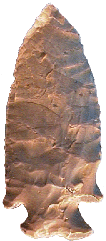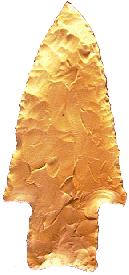



Point Type: HARDIN
BARBED
Also See: Buck Creek
Barbed, Cypress Creek, Decatur, Kirk Corner Notched , Lost Lake, Patuxent Stemmed, Scottsbluff , St. Charles aka Dovetail, Stilwell , Urich, Wills Creek
Location: Midwestern to Eastern United States
Associated Dates:
10,000-7000 B.P. - Early Archaic
Morphology: Stemmed or Corner
Notched
General Description: The Hardin Barbed blade is a large sized, well made excurvate to triangular barbed point or knife form with and expanding base that is usually ground. Resharpened examples will have one beveled edge on each face. The Hardin Barbed is believed to have evolved from the Scottsbluff types I and II. Pristine examples of the Hardin Barbed blade are often large and wide, have excurvate blade edges and exhibiting a fine overall flaking quality. Hardin Barbed blades were resharpened using a combination of left-hand beveling and serration. The resharpened specimens have straight to incurvate blade edges and are more triangular in shape. The Hardin has short downward projecting barbs that can flare outward. The expanding stem can vary to nearly straight in some examples. The basal edge can be straight to slightly concave. Heavy grinding on the base is typical. Some Hardin blades show a kind of fishtail or indented base, these are not considered a subtype. It is suggested that the Hardin Barbed was intended for initial use as a knife blade, the evidence being the resharpening and use wear found on many specimens.
Unlike the Dalton, the Hardin has not been been named as to the shape variety. At least 5 or 6 different major shape variants are known.
The average size of the Hardin Barbed point is 79 mm in length with the range being 49 - 180 mm. The average width is 66 mm wide across the barbs, 8.5 mm thick with a stem 17.5 mm long and 26 mm wide. The point was named by Edward G. Scully in 1951 for examples which were recovered from sites near Hardin, Calhoun County which is near the central Mississippi Valley of Illinois and Eastern Missouri. The point type is primarily found in Illinois, Missouri, western and southern Indiana, western Kentucky, western Tennessee, northern Arkansas, Ohio, Michigan, Wisconsin, Minnesota and eastern Iowa.
About The Point Above (Left): The small Hardin Barbed blade pictured at the top of this page, was found in Illinois. The point is made from a beautiful mustard colored flint which may be Cobden Chert. This blade is not the best example for the type, showing great size reduction due to edge resharpening. Additionally, the barbs on both shoulders have chipped or totally resharpened off, one being historically retouched the other not. The blade exhibits deep resharpening bevels which are left-handed and fine serrations. The base is heavily ground as are the base sides. The base edge has been thinned by the removal of two short flakes which are clearly shown in the photo. Overall, the point measures 66 mm in length, is 29 mm wide across the now barbless shoulders, and is only 8 mm thick in mid blade. The stem is 14 mm long and the base of the stem is 24 mm wide. The stem is 5 mm thick at mid point. Catalog Number 11A-49-C
About The Point Above (Right): The average sized Hardin Barbed point on the right at the top of this page measures 72 mm in length, is 39 mm wide at the barbs and is 9 mm thick at mid blade just above the barbs. The stem is of the fishtail or indented style and is 12 mm long and the basal ears are 22 mm wide. The stem is 5.5 mm thick at mid point and the indent is 1.5 mm deep. The point represents a near pristine Hardin Barbed fishtail variety, however there is a small nick out of the lower or left hand blade edge and there is also a nick just above the right hand barb which appears to be smooth indentation but is not. The blade is made from a light gray flint which has slight cracks which run across the blade. These cracks define increasingly lighter colored bands of flint with the overall effect being very pleasing to behold. The point is heavily patinated and the base and stem edges are moderately ground. The point is from the former Johnnie Woodard Collection and provenience information indicates it was found outside of the town of Dickson, Dickson County, Tennessee. Catalog Number 159-35-D
About The Point Below: The large Hardin Barbed point at the bottom of this page measures 84 mm in length, is 37 mm wide at the barbs and is 8 mm thick at mid blade just above the barbs. The stem is the straight style with a mild concavity and is 22 mm long and is 22 mm wide at the base. The stem is 6 mm thick at mid point and the concavity is 2 mm deep. The point represents a near pristine Hardin Barbed variety, however there is a small nick out of the upper or left hand blade edge. The blade is made from a light yellowish golden colored flint which has darker redish brownish stains. The point is heavily patinated and the base and stem edges are moderately ground. This point has not been reworked thus there are no blade edge bevels. The point was found near the town of Dalton, Randolph County, Arkansas. Catalog Number 158-65-D

References: Hranicky, Dragoo (c, e), Justice, Overstreet, Perino (1), Waldorf
© Copyright 1997 - 2008 LITHICS-Net WWW.LITHICSNET.COM
Use your Browser's BACK Button to return to the LITHICS-Net Index.